广东新型城镇化高质量发展研究
广东建设创新型城镇的实践分析与理论探索
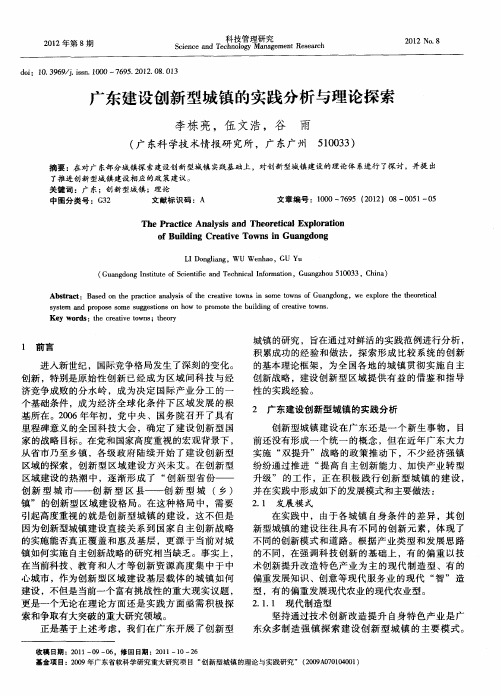
( und n stt o ceti adTc ncl nom t n G agh u5 0 3 , h a G ag ogI tue f i ic n eh i fr a o , unzo 10 3 C i ) n i S nf aI i n
( 东科 学技术情报研 究所 ,广 东广州 5 0 3 ) 广 10 3
摘 要 :, t -  ̄r f 东部分城镇探 索建设 创新型城镇 实践基础上 ,对创 新型城镇 建设的理论体 系进行 了探讨 ,并提 出 了推进创新型城镇建设相 应的政 策建议。 关 键 词 :广 东 ;创 新 型 城 镇 ;理 论 中图分类号 :G 2 3 文献标 识码 :A
1 前 言
进 入新 世 纪 ,国 际竞争 格 局发 生 了深 刻 的变化 。 创 新 ,特别 是 原始 性 创 新 已 经成 为 区 域 间 科 技 与 经 济竞争成败 的分水岭 ,成为决定 国际产业分工 的一
城镇 的研 究 ,旨在 通过 对鲜 活 的实 践 范例 进 行分 析 , 积累 成功 的经 验 和做 法 ,探 索形 成 比较 系 统 的创 新 的基本 理论 框 架 ,为全 国各 地 的城 镇 贯 彻 实 施 自主 创新战略 ,建设创新 型区域提供有益 的借鉴 和指导 性 的实践 经验 。 2 广 东建 设创 新型 城镇 的实践分 析 创新 型城 镇 建 设 在 广 东 还 是 一 个 新 生 事 物 , 目 前 还 没有 形成 一 个 统 一 的概 念 ,但 在 近年 广东 大 力 实施 “ 双提升” 战略的政策推动下,不少经济强镇 纷纷通过推进 “ 提高 自主创新 能力 、加快产业转型 升级 ” 的 工 作 ,正 在 积 极 践 行 创 新 型 城 镇 的 建 设 , 并在实践 中形成如下的发展模式和主要做法 : 2 1 发 展模 式 . 在实践 中 , 由于各 城镇 自身 条件 的 差 异 ,其 创 新 型 城镇 的建 设 往 往 具 有 不 同 的创 新 元 素 ,体 现 了 不 同的创新 模 式 和 道 路 。根 据 产 业 类 型 和 发 展 思 路 的不 同 ,在强 调 科 技 创 新 的基 础 上 ,有 的偏 重 以技 术 创新 提 升改 造 特 色 产 业 为 主 的现 代 制 造 型 、有 的
广东新型城镇化差异水平测度
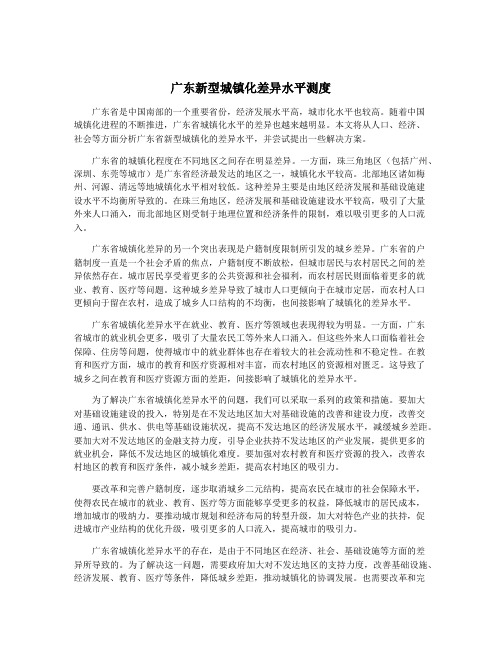
广东新型城镇化差异水平测度广东省是中国南部的一个重要省份,经济发展水平高,城市化水平也较高。
随着中国城镇化进程的不断推进,广东省城镇化水平的差异也越来越明显。
本文将从人口、经济、社会等方面分析广东省新型城镇化的差异水平,并尝试提出一些解决方案。
广东省的城镇化程度在不同地区之间存在明显差异。
一方面,珠三角地区(包括广州、深圳、东莞等城市)是广东省经济最发达的地区之一,城镇化水平较高。
北部地区诸如梅州、河源、清远等地城镇化水平相对较低。
这种差异主要是由地区经济发展和基础设施建设水平不均衡所导致的。
在珠三角地区,经济发展和基础设施建设水平较高,吸引了大量外来人口涌入,而北部地区则受制于地理位置和经济条件的限制,难以吸引更多的人口流入。
广东省城镇化差异的另一个突出表现是户籍制度限制所引发的城乡差异。
广东省的户籍制度一直是一个社会矛盾的焦点,户籍制度不断放松,但城市居民与农村居民之间的差异依然存在。
城市居民享受着更多的公共资源和社会福利,而农村居民则面临着更多的就业、教育、医疗等问题。
这种城乡差异导致了城市人口更倾向于在城市定居,而农村人口更倾向于留在农村,造成了城乡人口结构的不均衡,也间接影响了城镇化的差异水平。
广东省城镇化差异水平在就业、教育、医疗等领域也表现得较为明显。
一方面,广东省城市的就业机会更多,吸引了大量农民工等外来人口涌入。
但这些外来人口面临着社会保障、住房等问题,使得城市中的就业群体也存在着较大的社会流动性和不稳定性。
在教育和医疗方面,城市的教育和医疗资源相对丰富,而农村地区的资源相对匮乏。
这导致了城乡之间在教育和医疗资源方面的差距,间接影响了城镇化的差异水平。
为了解决广东省城镇化差异水平的问题,我们可以采取一系列的政策和措施。
要加大对基础设施建设的投入,特别是在不发达地区加大对基础设施的改善和建设力度,改善交通、通讯、供水、供电等基础设施状况,提高不发达地区的经济发展水平,减缓城乡差距。
广东新型城镇化差异水平测度

广东新型城镇化差异水平测度广东省作为中国最具有地区特色和经济发达的省份之一,城镇化水平在全国也居于前列。
但是,在广东省的城镇化发展过程中,不同地区之间的城镇化差异较大,因此,进行差异水平测度非常重要。
(一)广东省城镇化现状目前,广东省的城镇化率已经达到了67.82%,城镇人口超过了4400万人,其中一线城市和二线城市占据了很大的比例,这些城市的经济发展和资源聚集效应远高于其他城市。
除此之外,广东省还拥有多个相对发达的特色小城市和新兴城镇。
虽然广东省的城镇化有一定的基础,但是不同地区之间的城镇化发展水平存在较大的差异,其中产生这种差异性的原因可能是由于不同城市间在经济、社会、文化、地理等方面的发展条件不同,也可能是由于不同城市各自的发展战略、城市政策、空间规划等的差异性。
广东省城镇化差异水平具有以下几个方面的表现:1. 城市规模差异广东省城市之间的规模大小存在较大差异。
其中广州、深圳、珠海等一线城市、二线城市的规模大、人口密集程度高,而其他城市的规模相对较小、人口密集程度低。
这种差异导致了各个城市在城镇化发展的速度和质量方面都不相同。
2. 经济发展差异广东省各城市的经济发展水平差异很大。
一些城市由于发展比较早、发展条件较好,经济发达程度高,如广州、深圳等一线城市;另一些城市由于自然条件较为优越,具有独特的资源优势,例如湛江、茂名等地,具有较高的经济发展水平;但仍有一些城市由于发展环境较为恶劣,需要面对较多的困难和挑战,例如清远、梅州等地,经济发展水平相对较低。
3. 城市空间布局差异广东省城市之间的空间布局也存在很大差异。
一些城市由于其地理位置优越、交通便捷,成为了政治、文化、经济中心,例如广州、深圳等城市;而另一些城市则由于地理位置较为偏僻、地势低洼,不容易进行经济发展,如韶关、汕尾等地。
(三)测度方法衡量广东省城镇化中差异水平的指标主要包括城镇人口比重、城市化率、财政支出和工业经济发展水平等。
1. 城镇人口比重城镇人口比重是衡量城镇化水平的重要指标,广东省各地区城镇人口比重的高低可用来衡量城镇化水平的差异。
新型城镇化建设调研报告

新型城镇化建设调研报告一、引言城镇化是现代化的必由之路,新型城镇化更是推动经济高质量发展、实现全面建设社会主义现代化国家的重要引擎。
为深入了解新型城镇化建设的现状、问题和发展趋势,我们进行了此次调研。
二、调研目的与方法(一)调研目的本次调研旨在全面了解新型城镇化建设的推进情况,分析存在的问题和挑战,为进一步推动新型城镇化高质量发展提供参考依据。
(二)调研方法我们采用了多种调研方法,包括文献研究、实地考察、问卷调查和访谈等。
通过查阅相关政策文件、学术研究报告,了解新型城镇化的理论和政策背景;实地走访了多个城镇,观察城镇建设的实际情况;发放问卷,收集居民对城镇化建设的看法和需求;与政府官员、企业代表、居民进行访谈,获取第一手资料和深入见解。
三、新型城镇化建设的现状(一)城镇规模不断扩大近年来,随着经济的快速发展和人口的流动,许多城镇的规模不断扩大。
新建的住宅区、商业区和工业区逐渐向外拓展,城镇的建成区面积不断增加。
(二)基础设施逐步完善道路交通、供水供电、通信网络等基础设施建设取得显著成效。
高速公路、铁路的贯通,使得城镇之间的联系更加紧密;城镇内部的道路网络不断优化,交通拥堵状况得到一定程度的缓解。
同时,供水、供电能力不断提升,保障了居民和企业的正常生产生活。
(三)产业发展势头良好各地根据自身资源禀赋和产业基础,积极发展特色产业。
一些城镇依托制造业、加工业形成了产业集群;有的城镇则以旅游业、服务业为重点,推动了经济的多元化发展。
(四)公共服务水平不断提高教育、医疗、文化等公共服务设施逐步完善。
新建和扩建了一批学校、医院,引进了优质的教育和医疗资源,提高了公共服务的供给能力和质量。
四、新型城镇化建设存在的问题(一)产业支撑不足部分城镇产业发展缺乏特色和竞争力,产业结构单一,难以提供足够的就业机会,导致人口外流,城镇发展动力不足。
(二)土地利用效率不高在城镇扩张过程中,存在土地闲置、低效利用的现象。
一些工业园区土地利用率低,部分商业用地开发缓慢。
广东新型城镇化现状问题与对策

广东新型城镇化现状问题与对策发布日期:2014-12-09 阅读数:76内容摘要:改革开放以来,广东城镇化进程不断加快,城镇化水平由1978年的16.3 %上升到2013年的67.76 %,城镇的规模和人口不断扩大,城乡经济快速增长,产业结构与人口就业结构升级优化,社会事业快速发展,社区环境与生态建设较大改善。
本文对广东新型城镇化现状特点、存在问题进行分析,并提出推进新型城镇化的对策。
关键词:新型城镇化现状问题对策一、现状及特点(一)城镇化发展处于较高水平。
广东城镇化经过20世纪末高速发展后,进入21世纪达到较高水平。
2000-2010年,广东城镇人口比重上升了10.52个百分点,平均每年提高1.05个百分点。
2013年末,全省城镇人口7212万人,城镇化水平为67.76 %,比全国高14.03百分点,分别高于江苏、浙江、山东省3.65、3.76、14.01个百分点,仅低于京、津、沪三个直辖市。
参照美国城市地理学家诺瑟姆城市化发展进程三个阶段的研究理论,目前广东城镇化已进入中后期的发展阶段,珠江三角洲地区的城镇化率达84%,已进入城镇化发展的成熟阶段。
(二)人口就业结构不断优化。
随着广东经济迅速发展和城镇化水平不断提高,大量劳动力从农村涌向城镇,从第一产业转向第二、三产业,劳动力就业结构和产业构成发生了很大改变,二、三产业从业人员比重大幅度提高。
2013年广东全社会从业人员中,三大产业构成为23:42:35,二十多年间,第一产业从业人员比重下降了30多个百分点,而第二、三产业分别上升了15个百分点左右。
从GDP构成看,2013年全省三大产业构成为4.9:47.3:47.8,第一产业比重下降了近20个百分点,二、三产业分别上升了10个百分点,人口就业结构与经济结构变化一致。
(三)城镇建设步伐加快。
在城镇体系建设方面,全省已逐步形成珠江三角洲地区率先发展、东西两翼稳步发展、粤北地区加快发展的区域格局,以及大中小城市与小城镇协调发展的城镇体系。
广东城镇化的现状特征与问题

广东城镇化的现状特征与问题1978-2013年,中国城镇常住人口从1.7亿人增加到7.3亿人,城镇化率从17.9%提升到53.7%,年均提高1.02个百分点。
截至2012年末,广东城镇化率达到67.4%,居全国前列;其中,珠江三角洲地区的城镇化率达83.84%,已进入城镇化发展的成熟阶段。
一、广东经济产业中国第一经济大省,已达到中上等收入国家水平、中等发达国家水平。
生产总值(GDP):2013年6.23万亿元,占全国比重12.5%。
人均GDP超8000美元。
1988年以来GDP连续25年全国第一。
广东GDP增长图二、广东空间分区(一)行政区划下辖21个省辖市,其中副省级城市2个,地级市19个。
(二)划分四个区域珠三角地区;粤东沿海;粤西沿海;粤北山区。
(三)区域发展差异明显珠三角:步入后工业化时期,是世界上最大的都会区和大都市区之一其他地区:工业化初中期广东近10年各地市人口增长情况广东省2012年四大板块区域生产总值(亿元)三、人口分布与流动 广东是中国人口最多,社会、文化最开放的省份,居粤的外国人士达百万,在语言风俗、传统、历史文化等方面都有着独特风格,内部有广府、客家、潮汕等民系,是岭南文化的重要传承地。
人口:2012年末全省常住人口10594万人,占全国比重7.6%,为全国人口第一大省(区)。
2000年至今人口空间流动四、广东城镇化的空间差异四大板块城镇化率(%)五、国家新型城镇化规划识别的问题大量农业转移人口难以融入城市社会,市民化进程滞后。
“土地城镇化”快于人口城镇化,建设用地粗放低效。
城镇空间分布和规模结构不合理,与资源环境承载能力不匹配。
城市管理服务水平不高,“城市病”问题日益突出。
自然历史文化遗产保护不力,城乡建设缺乏特色。
体制机制不健全,阻碍了城镇化健康发展。
六、普遍性的问题广东也明显(一)发展效益欠佳,粗放发展模式普遍第一层级:高度城市化下实现高土地效益,以深圳、广州为代表;第二层级:高度城市化下实现中等土地效益,包括佛山、东莞等4个珠三角城市;第三层级:中等城镇化下土地效益有待提高,包括汕头潮州,应重在提升质量;第四层级:粤东西北大部分城市,城镇化率较低,同时土地效益低,未能形成一定的规模和集聚效应。
广东新型城镇化差异水平测度
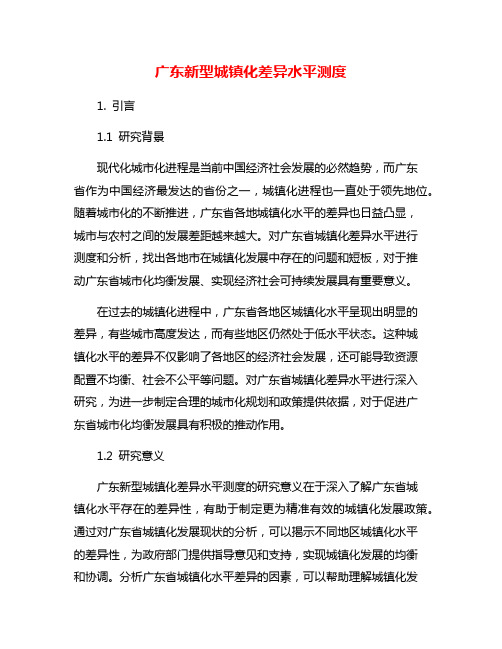
广东新型城镇化差异水平测度1. 引言1.1 研究背景现代化城市化进程是当前中国经济社会发展的必然趋势,而广东省作为中国经济最发达的省份之一,城镇化进程也一直处于领先地位。
随着城市化的不断推进,广东省各地城镇化水平的差异也日益凸显,城市与农村之间的发展差距越来越大。
对广东省城镇化差异水平进行测度和分析,找出各地市在城镇化发展中存在的问题和短板,对于推动广东省城市化均衡发展、实现经济社会可持续发展具有重要意义。
在过去的城镇化进程中,广东省各地区城镇化水平呈现出明显的差异,有些城市高度发达,而有些地区仍然处于低水平状态。
这种城镇化水平的差异不仅影响了各地区的经济社会发展,还可能导致资源配置不均衡、社会不公平等问题。
对广东省城镇化差异水平进行深入研究,为进一步制定合理的城市化规划和政策提供依据,对于促进广东省城市化均衡发展具有积极的推动作用。
1.2 研究意义广东新型城镇化差异水平测度的研究意义在于深入了解广东省城镇化水平存在的差异性,有助于制定更为精准有效的城镇化发展政策。
通过对广东省城镇化发展现状的分析,可以揭示不同地区城镇化水平的差异性,为政府部门提供指导意见和支持,实现城镇化发展的均衡和协调。
分析广东省城镇化水平差异的因素,可以帮助理解城镇化发展的内在规律和影响因素,为优化城镇化政策提供科学依据。
对广东省各地市城镇化水平差异进行分析,可以帮助各地市深入了解自身城镇化发展面临的情况和挑战,为未来城镇化发展路径提供指导。
研究广东新型城镇化差异水平的意义在于推动实现城市化进程的协调发展,促进经济社会的可持续发展。
1.3 研究目的本文旨在深入分析广东省新型城镇化差异水平,并探讨其中的原因和影响,旨在为相关决策提供科学依据。
具体研究目的如下:通过对广东省城镇化发展现状的分析,揭示各地市的城镇化水平差异,探讨其背后的原因和特点,为进一步研究提供基础数据。
通过分析广东省城镇化水平差异的影响因素,包括经济发展水平、政策支持、人口流动等方面的影响,以揭示城镇化差异形成的原因和机制。
广东新型城镇化差异水平测度
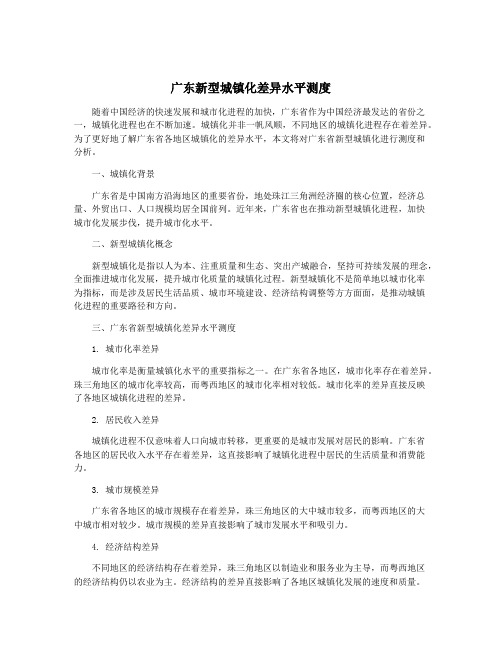
广东新型城镇化差异水平测度随着中国经济的快速发展和城市化进程的加快,广东省作为中国经济最发达的省份之一,城镇化进程也在不断加速。
城镇化并非一帆风顺,不同地区的城镇化进程存在着差异。
为了更好地了解广东省各地区城镇化的差异水平,本文将对广东省新型城镇化进行测度和分析。
一、城镇化背景广东省是中国南方沿海地区的重要省份,地处珠江三角洲经济圈的核心位置,经济总量、外贸出口、人口规模均居全国前列。
近年来,广东省也在推动新型城镇化进程,加快城市化发展步伐,提升城市化水平。
二、新型城镇化概念新型城镇化是指以人为本、注重质量和生态、突出产城融合,坚持可持续发展的理念,全面推进城市化发展,提升城市化质量的城镇化过程。
新型城镇化不是简单地以城市化率为指标,而是涉及居民生活品质、城市环境建设、经济结构调整等方方面面,是推动城镇化进程的重要路径和方向。
三、广东省新型城镇化差异水平测度1. 城市化率差异城市化率是衡量城镇化水平的重要指标之一。
在广东省各地区,城市化率存在着差异。
珠三角地区的城市化率较高,而粤西地区的城市化率相对较低。
城市化率的差异直接反映了各地区城镇化进程的差异。
2. 居民收入差异城镇化进程不仅意味着人口向城市转移,更重要的是城市发展对居民的影响。
广东省各地区的居民收入水平存在着差异,这直接影响了城镇化进程中居民的生活质量和消费能力。
3. 城市规模差异广东省各地区的城市规模存在着差异,珠三角地区的大中城市较多,而粤西地区的大中城市相对较少。
城市规模的差异直接影响了城市发展水平和吸引力。
4. 经济结构差异不同地区的经济结构存在着差异,珠三角地区以制造业和服务业为主导,而粤西地区的经济结构仍以农业为主。
经济结构的差异直接影响了各地区城镇化发展的速度和质量。
四、城镇化差异的原因分析1. 区域发展不平衡广东省各地区的区域发展不平衡是城镇化差异的主要原因之一。
珠三角地区的地理位置、区位优势、产业集聚效应等因素,使其城镇化发展相对较快;而粤西地区的地理条件和经济基础相对较弱,城镇化进程相对滞后。
促进广东城镇化可持续健康发展的机制和政策研究——以博罗县城镇化发展为例

促 进 广 东 壤 镇 了 匕可 持 续 建 康 发 展 的
讥 { } ; = = 『 和 政 策 研 究
以博 罗县城 镇 化 发 展 为例
广 东省 产 业发 展 研 究 院课 题 组 术
析 , 可 以为全 国 的城 镇 化 发 展 提 供 经 验 , 并 起 到
要 原 因之 一 , 促 进城 镇 化持续 健 康 发展 将 成 为拉
动 内需 的战 略选择 。 ②
另外 , 欧 美 国家 再 工 业 化 促 使 国 际 分 工 出 现 新变化、 资 源 环 境 约 束 日趋 严 格 、 产 能 过 剩 进 一 步加剧 、 全 球 经 济 增 长 放 缓 等 一 定 程 度 上 将 制 约 广 东城 镇 化 的未 来 发 展 , 但同时, 产 业 结 构 向服
务化、 资本 技术 密集 化发 展为 广 东省 城镇 化 加 快
窗 口和 杠 杆 的 作 用 。基 于 此 , 广 东 省产 业 发展 研
究院 2 0 1 2年 5月 开 始 就 珠 三 角 地 区 的 博 罗 县 城 镇 化 发 展 情 况 开 展 调 研 。 本 文 是 这 次 调 研 活 动
摘 要: 低水平城镇化是广东省 内需难以有效释放 的重要原 因之一, 促进城镇化持
续健 康 发展将 成 为拉 动 内需 的战略选 择 , 也是 广 东顺 利 实现 转 型 升级 的关键 之 一。 广 东省 发 改委将 博 罗县列 为发展 建设 规 划编 制试 点 县 , 该 县 自然条 件 、 经 对促进广东省城镇化持续健康发展 的相关研 究 具有很好的借鉴意义。实证分析发现: 博罗县在城镇化发展上 , 存在城镇化滞后于 工业化、 产业发展和城镇建设无序、 公共服务供 给与需求严重不平衡、 农 业发展 与
广东省城市化发展分析
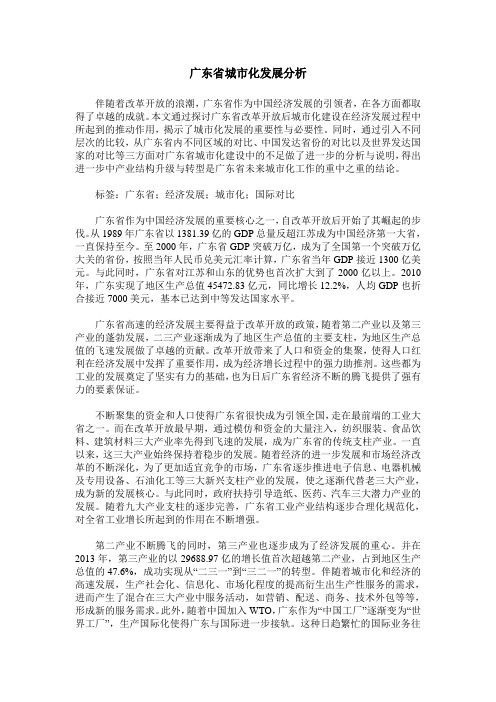
广东省城市化发展分析伴随着改革开放的浪潮,广东省作为中国经济发展的引领者,在各方面都取得了卓越的成就。
本文通过探讨广东省改革开放后城市化建设在经济发展过程中所起到的推动作用,揭示了城市化发展的重要性与必要性。
同时,通过引入不同层次的比较,从广东省内不同区域的对比、中国发达省份的对比以及世界发达国家的对比等三方面对广东省城市化建设中的不足做了进一步的分析与说明,得出进一步中产业结构升级与转型是广东省未来城市化工作的重中之重的结论。
标签:广东省;经济发展;城市化;国际对比广东省作为中国经济发展的重要核心之一,自改革开放后开始了其崛起的步伐。
从1989年广东省以1381.39亿的GDP总量反超江苏成为中国经济第一大省,一直保持至今。
至2000年,广东省GDP突破万亿,成为了全国第一个突破万亿大关的省份,按照当年人民币兑美元汇率计算,广东省当年GDP接近1300亿美元。
与此同时,广东省对江苏和山东的优势也首次扩大到了2000亿以上。
2010年,广东实现了地区生产总值45472.83亿元,同比增长12.2%,人均GDP也折合接近7000美元,基本已达到中等发达国家水平。
广东省高速的经济发展主要得益于改革开放的政策,随着第二产业以及第三产业的蓬勃发展,二三产业逐渐成为了地区生产总值的主要支柱,为地区生产总值的飞速发展做了卓越的贡献。
改革开放带来了人口和资金的集聚,使得人口红利在经济发展中发挥了重要作用,成为经济增长过程中的强力助推剂。
这些都为工业的发展奠定了坚实有力的基础,也为日后广东省经济不断的腾飞提供了强有力的要素保证。
不断聚集的资金和人口使得广东省很快成为引领全国,走在最前端的工业大省之一。
而在改革开放最早期,通过模仿和资金的大量注入,纺织服装、食品饮料、建筑材料三大产业率先得到飞速的发展,成为广东省的传统支柱产业。
一直以来,这三大产业始终保持着稳步的发展。
随着经济的进一步发展和市场经济改革的不断深化,为了更加适宜竞争的市场,广东省逐步推进电子信息、电器机械及专用设备、石油化工等三大新兴支柱产业的发展,使之逐渐代替老三大产业,成为新的发展核心。
广东新型城镇化差异水平测度

广东新型城镇化差异水平测度广东是中国的经济大省,也是中国新型城镇化改革的先行者之一。
随着经济的快速发展,广东的城镇化水平不断提升,但不同地区之间的城镇化差异也变得愈发明显。
本文将从宏观和微观两个角度对广东新型城镇化差异水平进行测度和分析,以期为更加精准地推进广东城镇化进程提供科学依据。
一、宏观层面测度在宏观层面测度广东新型城镇化差异水平时,我们可以从以下几个方面进行分析。
1. 城镇化率比较城镇化率是衡量一个地区城镇化水平的重要指标,是城镇人口占总人口比例的指标。
根据广东省统计局的数据,广东省城镇化率在过去几年间一直保持在较高水平,但各个地级市之间的城镇化率仍存在差异。
珠海、深圳、广州等发达地区的城镇化率较高,而一些较为欠发达的地区如梅州、汕尾的城镇化率相对较低。
这种城镇化率的差异反映了不同地区的发展水平和城镇化进程的不平衡性。
2. 城镇化质量评估除了城镇化率,我们还可以从城镇化的质量方面进行评估。
城镇化质量包括城市规模结构、产业结构、居民生活水平等多个方面。
一些地级市虽然城镇化率不低,但城市规模小、产业单一、居民收入低下,城镇化质量较低。
这种情况的存在,也反映了广东城镇化水平的差异。
城镇化协调性指城市化、产业化、农业现代化等发展形式与空间组织之间的协调性。
如果一个地区的城镇化过程中各个方面的发展都比较协调,那么这个地区的城镇化协调性就较高。
反之,如果某一方面发展过快,而其他方面滞后,那么这个地区的城镇化协调性就相对较低。
在广东省,不同地区的城镇化协调性也存在差异,造成了城镇化差异的进一步拉大。
1. 城乡发展差距城镇化差异的产生与城乡发展差距息息相关。
在广东省,发达地区的城镇化进程明显快于欠发达地区,在城市化、产业化、现代化等方面取得了更大的成就,这导致了城乡发展差距的扩大,也加大了城镇化差异的程度。
2. 人口流动与就业机会广东省的城镇化过程也伴随着大量的人口流动,特别是农村劳动力向城市转移。
但不同地区的城镇化进程不一样,导致了人口流动的不均衡。
广东新型城镇化差异水平测度

广东新型城镇化差异水平测度广东省作为我国经济最发达、城镇化水平最高的地区之一,其城镇化发展模式和水平受到了广泛关注。
随着改革开放以来,广东省城镇化进程经历了快速发展和转型升级,不同地区的城市化水平差异较大。
对广东省新型城镇化差异水平进行测度,有利于更好地理解和把握城镇化发展的实际情况,为政府决策和规划提供科学依据。
一、广东新型城镇化的特点广东省地域辽阔,东南沿海地区发达,而西北部地区相对落后。
这导致广东省城镇化进程的差异性非常明显。
根据国家统计局公布的数据,2019年广东省城镇化率为74.9%,高于全国城镇化率16.7个百分点。
广东省城镇化率高于全国平均水平的城镇化水平在不同地区之间也存在显著差异。
在一线城市和部分发达地区,城镇化水平已经非常高,而在一些偏远地区和山区,城镇化水平则相对较低。
广东省城镇化进程中还存在着城乡差别、区域差异等问题。
城市人口的收入水平、社会保障水平等远远高于农村地区。
这导致了城市与农村之间在教育、医疗、社会保障等方面的差距,城乡居民的生活水平存在明显差异。
这种城乡差距同时也表现在基础设施和公共服务的分配上,城市地区更加发达,基础设施和公共服务相对充足,而农村地区发展滞后,基础设施和公共服务的不足成为制约农村发展的重要因素。
为了全面、客观地测度广东省不同地区的城镇化差异水平,需要选择一些合适的指标进行测度。
以下是一些可以测度城镇化差异水平的指标:1. 城市化率城市化率是城市人口占总人口比例的指标,是测度城镇化水平的重要指标之一。
根据广东省各地市的城市人口和总人口,可以计算出各地市的城市化率,进而分析城市化水平的高低和差异。
2. 经济发展水平城镇化水平与地区经济发展水平密切相关,因此经济发展水平也是衡量城镇化差异的重要指标。
地区的GDP总量、人均GDP以及工业化水平都可以反映城镇化水平的差异。
经济发达地区城镇化水平普遍较高,而经济欠发达地区城镇化水平相对较低。
3. 基础设施建设水平基础设施建设水平是城镇化水平的另一重要指标。
广州新型城市化发展路径研究
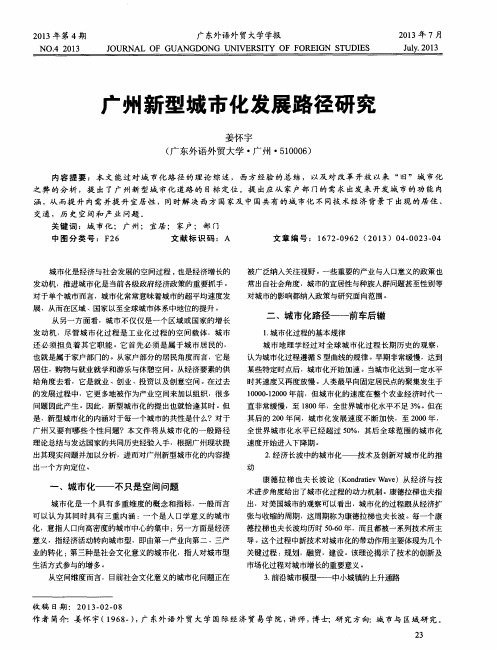
时其速度又再度放慢 。人类最 早向固定居 民点的聚集发生于 1 0 0 0 0 - 1 2 0 0 0年前 ,但城市化的速 度在整个农业经济 时代一
直非常缓慢 ,至 1 8 0 0年 ,全世界城市化水平不足 3 %。但在
的发展过程 中,它更多地 被作为产业空间来加以组织 ,很 多
问题 因此产生 。因此 ,新型城市化 的提 出也就恰 逢其时 。但
理论总结与发达国家的共同历史经验入手 ,根据广州现状提 出其现实问题并加以分析 ,进而对广州新型城市化的内容提
出一个方向定位
一
2 . 经济 长波中的城市化——技 术及创新对城市 化的推
动
、
城市化—— 不只是空 间问题
康 德拉 梯也 夫长 波论 ( K o n d r a t i e v Wa v e )从经 济与 技
也就是属 于家户部 门的 。从家户部分的居 民角度而言 ,它是 居住 ,购物 与就业就学和游乐与休憩空间 。从经济要素的供
给角度去 看,它是就业 、创业 、投 资以及创 意空间 。在过去
认为城市化过程遵循 s型曲线的规律 。 早期非常缓慢 ,达到
某些特定时点后 ,城市化开始 加速 。当城市化达到一定水平
2 0 1 3年 第 4期
NO. 4 2 0 1 3
广 东外语外 贸大学学报
J OURNAL OF GUANGDONG UNI VERS I TY OF FOREI GN S TUDI ES
2 0 1 3年 7月
J ul y . 2 01 3
广 州新型城 市化发展路 径研 究
2 3
广 东外语外 贸大学 学报
Wy c k o f 经过对丹佛市的观察 ,提 出中小城市 ,即其所 谓前沿城 市的发展需经历三个阶段 : 第一阶段 ,前沿城市规模 尚小 ,区域 中心地位的所 谓
广东城镇化发展与居民消费增长分析

年的居 民消费率的下 降主要是农村居民消费率的下降 ,
而 且 城 镇 居 民 消 费率 则 呈 现 卜 升状 态 。 乡居 民 消费 率 城 之 间相 差 2 个百 分 点 ( 7 见表 2) 。 20 —2 0 年 城 镇 率增 长 ,并 没 有 推 动最 终 消 费 00 09 率 和 居 民消 费率 的 I , 而 下 降 , 种 现象 是 符 合 同 反 升 这 际经 济 规 律 的 。根 据钱 纳 里 标 准 模 型 及 东亚 、 美 等 新 南 兴 闰家 的经 验 ,消 费率 的 变 化 轨 迹呈 平缓 的 u型 曲线 :
段 ,还具有较大的上升空间。2 0 年世界高收入 国家和 08 地区的城镇化水平 已达 7 . %, 76 6 中上等收入 国家和地区 的城镇化也高达7 . %( 4 7 见表 1 。 0 8 7 ) 2 0 年广东人均 G P D
达 到 56 美 元 , 于 中上 收 入 水 平 国家 的行 列 , 城镇 39 处 但
度 比较 低 ,只 有 5 以下 ,甚 至 2 0 % 0 3— 20 年 甚 至 出 04 现负增长 ( 见表 3) 从 以 上分 析 可 以看 到 ,2 0 年 以 。 00 来 ,城 镇 居 民消 费 对 广 东 G P增 长 的 影 响 程 度 是 比较 D 强 的 ,而 农 村 居 民消 费对 广 东 GD P增 长 的 影 响 却 在 减
12 0 东 济 4 2o 广 经 /1 3
的 4 %,跌 幅达 到 79 百 分点 ;但 城 镇 居 民消 费率 则 . 7 .个 呈 现 上 升 状 态 , 然 中问 有 波 动 , 从 20 年 的 2 .% 虽 但 00 91 【 到 20 年 的 3 .%,上涨 了 3 个 百 分 点 。纵 观 十 = 升 09 25 . 4
广东新型城镇化发展路径研究——基于制度创新视角
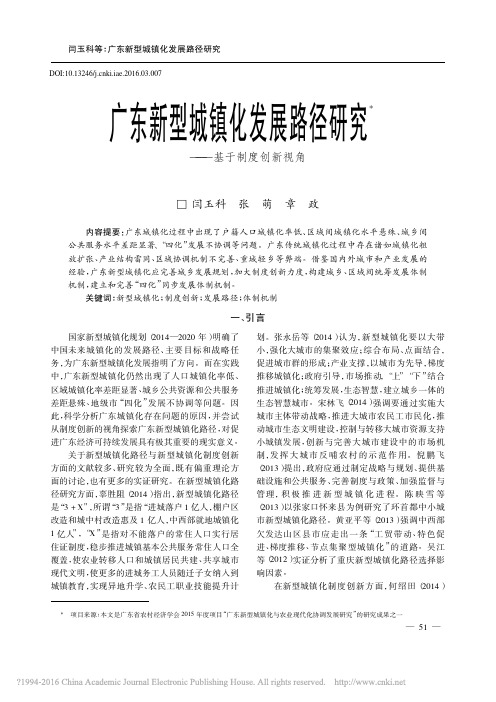
( 二) “双转移”制度执行不力,区域内及相邻 城市间产业结构雷同
2008 年 5 月 24 日,中共广东省委广东省人民 政府印发 了《关 于 推 进 产 业 转 移 和 劳 动 力 转 移 的 决定》,提出充分发挥产业转移联席会议制度和省 农民工工作联席会议制度的职能作用,实行领导负 责制,建立目标责任考评制度,把产业转移和劳动 力转移工作纳入经济社会发展规划和年度计划,并 要求建立政府间联系沟通工作机制。通过分析广 东省 2013 年 21 个地级市规模以上工业中各行业 占工业总产值的比重发现,广东四大区域内及相邻 城市间产业结构雷同,未能形成梯次继起的动态升 级的产业链。在珠三角地区 9 市中,计算机、通讯 和其他电子设备制造业,电气机械和器材制造业, 电力、热力生产和供应业与化学原料和化学制品制 造业均是 6 个以上城市共同的支柱产业( 见表 1) 。
二、广东传统城镇化存在的问题及其制度障碍
( 一) 僵化的财政和户籍制度导致广东人口城 镇化率低,城镇化以粗放式扩张为主
城镇化是人类生产与生活方式由农村型向城 镇型转变的历史过程,表现为农村人口向城镇转移 以及城镇 规 模 不 断 扩 大 与 功 能 不 断 完 善 的 过 程。 城镇化不是简单的城市常住人口比例增加和面积 扩张,而是要在产业支撑、人居环境、社会保障、生 活方式等方面实现由“乡”到“城”的转变,核心是 要解决人的城镇化问题,让人在城镇中更好地生产 和生活。1994 年的中国分税制改革没有做到事权 与财权的科学统一,中央政府税收比重过高,地方 政府缺乏可持续发展的财政汲取能力 ( 乔新生, 2007) 。在现行的财政和事权划分体制下,农民工 市民化产生的各种社会成本主要靠输入地城市政 府自行消化,使城市政府承受较大财政支出压力, 这是城市政府不愿向农民工开放户籍的根本原因 ( 卜凡,2014) ,因此,农民工的制度安排是地方政 府在面临财政约束的情况下做出的最理性的安排 — 52 —
广东省新型城镇化耦合协调的时空特征及驱动因素研究

广东省新型城镇化耦合协调的时空特征及驱动因素研究
丁增才;叶祥松;欧进锋
【期刊名称】《调研世界》
【年(卷),期】2024()3
【摘要】基于发展层次把新型城镇化划分为“城镇可持续发展”“城镇体系优化”“城乡一体化”三个子系统,运用耦合协调和灰色关联度模型研究广东省新型城镇化耦合协调的时空特征及驱动因素。
研究表明:2010—2021年间,广东省新型城镇化存在显著的区域差异,三个子系统的变化态势不尽相同,城镇可持续发展指数最高,城镇体系优化指数最低;子系统之间存在相互促进趋势,珠三角地区属于中度协调类型,粤东、粤西、粤北地区在中度失调和基本协调之间交替波动。
驱动因素按影响程度从强到弱排序依次为政府调控、经济基础、投资拉动、人力资本和产业结构。
最后,从强化顶层设计、制定差异化发展规划和完善区域协调发展体系等方面提出对策建议。
【总页数】11页(P50-60)
【作者】丁增才;叶祥松;欧进锋
【作者单位】伦敦国王学院数字经济学院;广州大学经济与统计学院;岭南师范学院商学院
【正文语种】中文
【中图分类】F061.3
【相关文献】
1.广东省城镇化与生态环境耦合协调的空间特征及影响因素研究
2.中国人口城镇化与土地城镇化协调发展的时空特征与驱动因素
3.安徽旅游产业与新型城镇化耦合协调时空演化及影响因素研究
4.新型城镇化与医疗服务水平耦合协调度的时空特征及驱动力识别
5.中国新型城镇化与低碳交通耦合协调时空格局及其驱动因素
因版权原因,仅展示原文概要,查看原文内容请购买。
新型城镇化问题研究——以广州市从化区为例
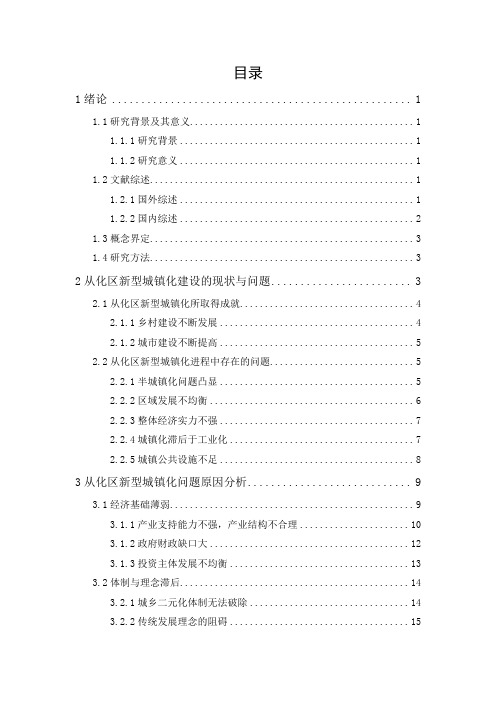
目录1绪论 (1)1.1研究背景及其意义 (1)1.1.1研究背景 (1)1.1.2研究意义 (1)1.2文献综述 (1)1.2.1国外综述 (1)1.2.2国内综述 (2)1.3概念界定 (3)1.4研究方法 (3)2从化区新型城镇化建设的现状与问题 (3)2.1从化区新型城镇化所取得成就 (4)2.1.1乡村建设不断发展 (4)2.1.2城市建设不断提高 (5)2.2从化区新型城镇化进程中存在的问题 (5)2.2.1半城镇化问题凸显 (5)2.2.2区域发展不均衡 (6)2.2.3整体经济实力不强 (7)2.2.4城镇化滞后于工业化 (7)2.2.5城镇公共设施不足 (8)3从化区新型城镇化问题原因分析 (9)3.1经济基础薄弱 (9)3.1.1产业支持能力不强,产业结构不合理 (10)3.1.2政府财政缺口大 (12)3.1.3投资主体发展不均衡 (13)3.2体制与理念滞后 (14)3.2.1城乡二元化体制无法破除 (14)3.2.2传统发展理念的阻碍 (15)3.3居民素质阻碍新型城镇化建设 (15)3.3.1人口文化素质水平低 (15)3.3.2劳动人口财政压力大 (16)4完善从化区新型城镇化发展的对策 (17)4.1推动产业发展 (17)4.2建立城乡一体化体制机制 (18)4.3加大对教育的投资 (18)4.4开拓多元的投资融资渠道 (19)5结论 (19)新型城镇化问题研究——以广州市从化区为例摘要:作为社会主义国家,中国在借鉴外国城市化的基础上,结合本国国情,建设中国特色的城镇化。
快速的城镇化虽然促进了经济社会的发展,但也存在许多弊端,因此国家通过对城镇化的不断完善,开始了新型城镇化的历程。
从此,新型城镇化便成为了党和国家的重要部署,也是重要的民生工程,其对促进社会全面进步有着极其重要的现实意义。
作为新型城镇化建设排头兵的广州市,在2018年就以优异的成绩通过了国家新型城镇化试点的考核,成为新型城镇化范例之一,但区域存在发展不平衡,发展差距较大的现象。
- 1、下载文档前请自行甄别文档内容的完整性,平台不提供额外的编辑、内容补充、找答案等附加服务。
- 2、"仅部分预览"的文档,不可在线预览部分如存在完整性等问题,可反馈申请退款(可完整预览的文档不适用该条件!)。
- 3、如文档侵犯您的权益,请联系客服反馈,我们会尽快为您处理(人工客服工作时间:9:00-18:30)。
Urbanization and Land Use 城镇化与集约用地, 2020, 8(3), 149-157Published Online September 2020 in Hans. /journal/uluhttps:///10.12677/ulu.2020.83015广东新型城镇化高质量发展研究闫玉科,黄丹萍,黄蕊婷广东海洋大学,广东湛江收稿日期:2020年8月6日;录用日期:2020年8月28日;发布日期:2020年9月4日摘要2018年,广东省城镇化已进入城市化增长曲线的稳定阶段,但2019年广东省常住人口城镇化率与户籍人口城镇化率的差值达到20%以上。
我们概述了广东城镇化发展的现状,分析了广东新型城镇化质量偏低原因,并提出了高起点制定新型城镇化发展规划,强化政府主导作用;树立新发展理念,实现“四化”良性互动;建立和完善高质量发展体制机制,释放制度活力创造发展动力等系列对策,促使广东新型城镇化高质量发展。
关键词新型城镇化,高质量发展,对策建议Research on High Quality Development ofNew Urbanization in GuangdongYuke Yan, Danping Huang, Ruiting HuangGuangdong Ocean University, Zhanjiang GuangdongReceived: Aug. 6th, 2020; accepted: Aug. 28th, 2020; published: Sep. 4th, 2020AbstractIn 2018, the urbanization of Guangdong Province has entered a stable stage of the urbanization growth curve, but in 2019 the difference between the urbanization rate of the permanent popula-tion of Guangdong Province and the urbanization rate of the registered population reached more than 20%. We have outlined the current situation of Guangdong’s urbanization development, analyzed the reasons for the low quality of Guangdong’s new urbanization, and proposed a high starting point to formulate a new urbanization development plan to strengthen the leading role of闫玉科 等the government; established a new development concept and realized the “four modernizations”; established and improved the high-quality development system and mechanism, released the vi-tality of the system to create development momentum and other series of countermeasures to promote the high-quality development of Guangdong’s new urbanization.KeywordsNew Urbanization, High-Quality Development, Countermeasures and SuggestionsCopyright © 2020 by author(s) and Hans Publishers Inc.This work is licensed under the Creative Commons Attribution International License (CC BY 4.0)./licenses/by/4.0/1. 广东城镇化发展现状从1990~2017年广东城镇化水平越来越高,经历了城市化增长曲线的起步阶段和快速发展阶段(如图1)。
2018年后进入了城市化增长曲线的稳定阶段。
目前,广东已形成了以等级序列排布的区域城镇体系,推动打造“一轴、多中心、集群式”城镇空间结构,不断强化中心镇、都市圈、城市扩容、中心城市的带动辐射能力。
虽然2018年广东省常住人口城镇化率突破70%,但户籍人口城镇化率还达不到50%,二者的差距反映出广东新型城镇化问题严重。
2019年,广东珠三角与粤东、粤西以及粤北山区间城镇化率差距悬殊,珠三角区域城镇化率分别是粤东、粤西和粤北山区城镇化率的1.42倍、1.93倍和1.73倍等。
广东新型城镇化发展质量偏低的主要原因如下:户口等制度强力限制导致农民工市民化严重滞后,城镇化与工业化间关系不协调,农业现代化与城镇化关系不协调,“四化”协调发展体制机制欠缺等。
Figure 1. Comparison of urbanization rates between China and Guangdong Province from 1990 to 2019图1. 1990~2019年中国与广东省城市化率对比2. 广东新型城镇化质量偏低原因2.1. 户口等制度强力限制,农民工市民化严重滞后改革开放以来,广东省经济一路突飞猛进,在广东务工的农民工是重要的贡献者,但由于农民工文化程度、职业技能、户籍制度、社会保障制度等种种因素的限制,市民化进程严重滞后,绝大多数农民工未能更多分享广东经济快递发展的红利。
绝大多数在珠三角区域务工的农民工劳动素质水平低,主要闫玉科等从事以体力劳动为主的职业,在就业、医疗、社会保险等方面缺乏应有保障,其子女很难在务工城市中接受九年制义务教育,对于农民工在城市落户尤其在一线城市落户存在着诸多限制,难以转变成为城市居民,无法享受平等的基本公共服务。
此外,大批农民工盲目地聚集在深圳、广州等一线城市中,比如2018年珠三角年末常住人口6300.99万人,其中城镇5413.11万人,而户籍总人口仅为3628.04万人,农民工总数达到了1785.07万人,给深圳、广州等一线城市社会的正常秩序和治安带来了众多不安定因素,也降低城市的宜居水平。
2.2. 房地产业成为城镇化的引擎,但其发展方向亟需矫正2003年,房地产行业被国家定位为支柱型行业。
房地产业已成为城镇化快速发展的引擎,但出现了土地城镇化快于人口城镇化等问题,2018年广东省住宅完成投资同比增长20.49%,住宅新开工面积同比增长15.80%,而广东人口城镇化增长率仅为1.22%。
市场上需求较高的经济适用房供给不足,而价格高昂的高端房却过分供给,供求结构失衡,尽管政府采取行动控制房地产价格,但效果不佳,房地产业过度开发的同时,也存在着恶意炒房的不良经济行为,使城市多个楼盘出现“空城”、“夜城”等现象。
对于广东各地区商品住宅静态供求比,东翼地区供求比波动幅度大,整体上商品住宅供过于求,而珠三角地区尤其是深圳、广州等大量外来劳动人口流入的一线城市,住房需求大,但土地供应紧缺,加大了住房供给的压力。
除了商品房,另一类就是政府的保障房,但广东省在保障房上的建设和投入都远远不足,很多地区的保障房无法满足居民的住房需求[1]。
2.3. 城镇化与工业化间关系不协调,限制了新型城镇化快速发展按照IU、NU国际标准值方法,IU = 劳动力工业化率/人口城镇化率,NU = 劳动力非农化率/人口城镇化率,当IU ≈ 0.5或NU ≈ 1.2时,表明“两化”发展基本协调[2]。
基于数据的局限性,本文以第二产业劳动力在总劳动力中的占比代替工业劳动力占总劳动力的占比,使得IU的测量值比实际值略有扩大。
2010~2018年广东省“两化”协调性比较结果如表1所示,广东省虽然城镇化与工业化之间协调性有所提高,但IU值、NU值总体上高于0.5、1.2,偏离度不大,全省城镇化水平略低于工业化发展水平。
Table 1. Comparison of the coordination of industrialization and urbanization in Guangdong Province表1.广东省工业化、城镇化协调性比较年份IU NU2010 0.640663 1.1423152011 0.637578 1.1443322012 0.623177 1.1306212013 0.618391 1.1364232014 0.60885 1.1412272015 0.596711 1.1337512016 0.58526 1.1315032017 0.574087 1.1252682018 0.55587 1.121641广东省1978年以来的历年城镇化率与工业化率见图2所示。
从宏观上看,广东省的工业化建设要先于城镇化建设,现阶段广东省的工业化和城镇化水平虽都已步入成熟阶段,但从微观上看,广东省除一闫玉科 等线城市外,其他大部分城市“二化”之间协调发展仍需加大力度。
世界经济联系日益紧密,为广东省带来了发展机遇,但珠三角各个城市的高房价,也为其发展带来了挑战,外来投资、劳动力、高端制造业有向长江三角洲地区、环渤海湾地区转移的趋势,广东省需进一步完善城镇基础设施和公共设施,加快人口城镇化步伐,提高人口承载力,缩小广东省新型城镇化与工业化发展的差距,化危为机,形成竞争新优势。
Figure 2. Comparison of urbanization rate and industrialization rate in Guangdong Province from 1978 to 2019. Data source: “Guangdong Statistical Yearbook”图2. 广东省1978-2019年城市化率与工业化率对比图。
数据来源:《广东统计年鉴》2.4. 农业现代化与城镇化关系不协调,新型城镇化水平难以提高本文采用的农业现代化指标体系结构由10个一级指标和15个二级指标组成,加权计算最终得分90分为基本达标[3]。
采用2019年《广东农村统计年鉴》等数据,按照指标进行加权计算,广东省的农业现代化建设水平在2016~2018年的各项指标值及结果如表2所示。
